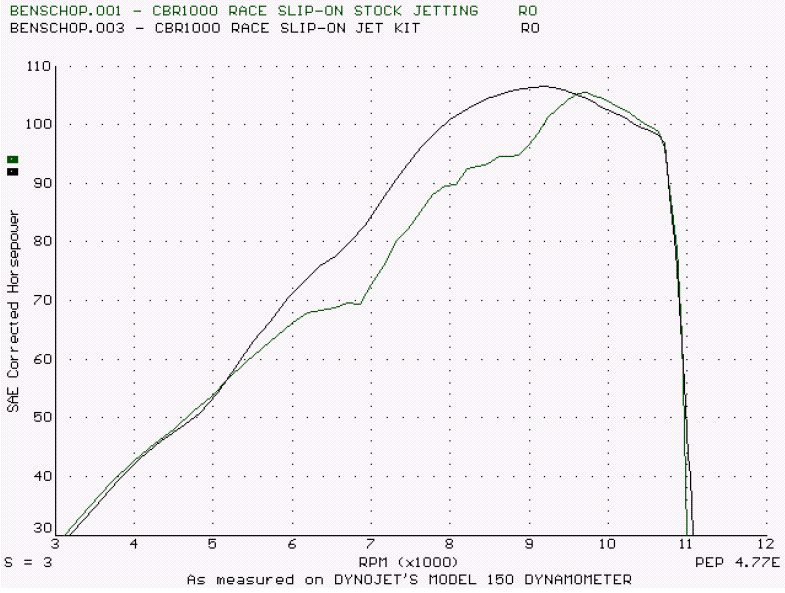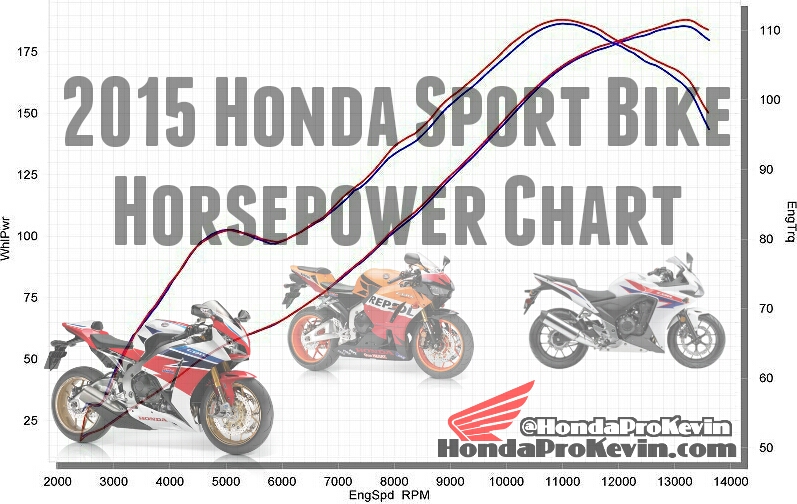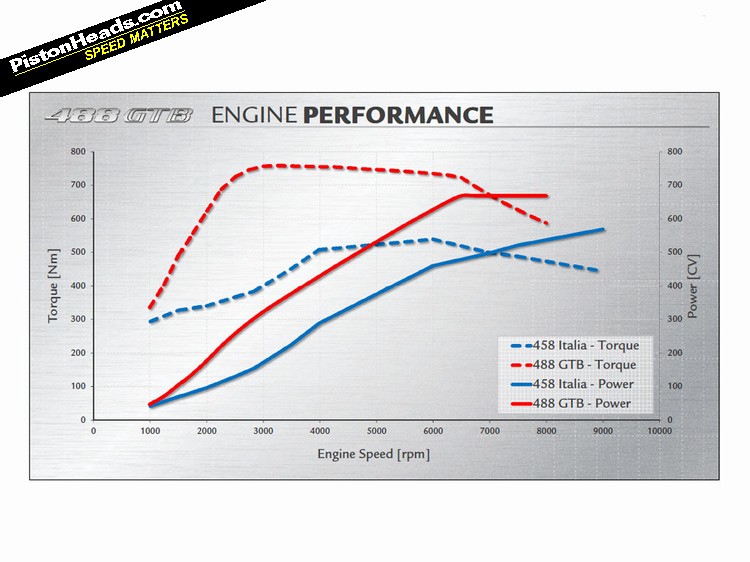
Gearing vs Torque vs Horsepower
#1

Posted 28 November 2017 - 10:06
Advertisement
#2

Posted 28 November 2017 - 18:16
What they found out ( i believe) on the sperbikes/streetbikes is that by increasing the rpm range you also get a wider powerband. So rpm could close the gaps a gearing normally would. If you think about it the difference in pulses are far less around 18k to 20k than 2k to 4k. 10% vs 100% So it is easier to tune for a wide powerband at high rpm vs low rpm. at 20k your just 10% off vs 100% off at 4k. This is simplified ofc. and lots of other factors is excluded.
To further increase the all round power you would allow a variable length intake runner++
Edited by MatsNorway, 28 November 2017 - 18:18.
#3

Posted 29 November 2017 - 13:11
You could just draw a spreadsheet or MATLAB or other code with your theoretical torque/power curve (and some estimates of resistive forces, drag coefficient and so on) and calculate the acceleration and road speed for different gearing choices and compare to bumping up to larger, more powerful engine with less gears. ![]()
#4

Posted 29 November 2017 - 13:47
I'd look at a very simple example first, like compare a 1 gear car with a 2 gear car. Power could be as simple as P=Pmax*Velocity/vmax
And acceleration=Force/mass when you don't consider drag and rolling resistance.
#5

Posted 29 November 2017 - 16:50
As alway, it's the area under the power curve.
With fewer gears you go further into the lower,steeper ends of the curve. Your average thrust is smaller.
#6

Posted 30 November 2017 - 02:29
What they found out ( i believe) on the sperbikes/streetbikes is that by increasing the rpm range you also get a wider powerband. So rpm could close the gaps a gearing normally would. If you think about it the difference in pulses are far less around 18k to 20k than 2k to 4k. 10% vs 100% So it is easier to tune for a wide powerband at high rpm vs low rpm. at 20k your just 10% off vs 100% off at 4k.
Mats, width of powerband should always be measured in %. eg an engine that makes 100hp from 2000 to 4000 rpm is comparable to one that makes 100hp from 5000 to 10,000 rpm.
#7

Posted 30 November 2017 - 07:50
#8

Posted 30 November 2017 - 10:35
Um, you can't expect to match the performance of an 8 speed gearbox, sensibly used, with a 4 speed gearbox.. If there was no point in having an 8 speed you wouldn't bother. Perhaps to take it to the extreme, imagine a perfect CVT. You'd run at peak power continuously and would not care about the shape of the torque curve. Compare it with a single speed gearbox, with say a torque converter that locks up at 3000 rpm at full throttle. You'd want an engine calibration that provides lots of torque at 3000 but to get that you'd have to lose some peak power. The CVT car would be faster. The shape of that tradeoff of peak power vs shape of the torque curve is easily done in any number of engine simulation packages, say GT power, and the effect of the different gearing and torque curves on lap time can be explored in Lapsim or any other simulator.
#9

Posted 30 November 2017 - 10:47
I was more envisaging comparisons between undersquare and oversquare engines, etc, etc, but your responses have prompted me on the road to research and has opened up a whole new world of engine shapes (height vs width vs length, etc), piston speed and associated friction, heat, etc, etc. Very interesting, and I'll keep reading.
If you are interested in that kind of thing try the game "Automation". You can fiddle with different bore and stroke, cam profiles (you can even add variable lift / VTEC!), OHV vs OHC... Then work out the estimated power and torque curves. Lots of fun! ![]()
Edited by V8 Fireworks, 30 November 2017 - 10:49.
#10

Posted 30 November 2017 - 10:48
Um, you can't expect to match the performance of an 8 speed gearbox, sensibly used, with a 4 speed gearbox.. If there was no point in having an 8 speed you wouldn't bother. Perhaps to take it to the extreme, imagine a perfect CVT. You'd run at peak power continuously and would not care about the shape of the torque curve. Compare it with a single speed gearbox, with say a torque converter that locks up at 3000 rpm at full throttle. You'd want an engine calibration that provides lots of torque at 3000 but to get that you'd have to lose some peak power. The CVT car would be faster. The shape of that tradeoff of peak power vs shape of the torque curve is easily done in any number of engine simulation packages, say GT power, and the effect of the different gearing and torque curves on lap time can be explored in Lapsim or any other simulator.
How come electric road cars (if I am not mistaken) often make do with a single speed, while a Formula E racecar has a multi-speed gearbox? ![]()
#11

Posted 30 November 2017 - 17:44
Tesla actually started with a 2 speed gearbox, but presumably decided it was more trouble than it was worth. A Formula E motor has a max torque of 130 Nm and a max power of 200 kW. They need all the help they can get to accelerate.WAG 800kg vehicle, 0.7g acceleration off the line (pretty pathetic) - so they need 5600N of thrust. Wheel radius say 0.35m so they need a wheel torque of 1960 so they need an overall gear ratio of 15 for a standing start. That's about the same as a typical road car with a real engine. They redline at 17000 rpm so the top speed in that gear would be 17000*2*pi*.35*60/15, 150 kph. So without a gearbox the formula E cars would have the same initial acceleration and top speed as a Lotus 7, which might not provide the spectacle the punters were hoping for.
Grins, I cheated a bit, but the numbers I've quoted are right.
#12

Posted 30 November 2017 - 20:16
Tesla actually started with a 2 speed gearbox, but presumably decided it was more trouble than it was worth. A Formula E motor has a max torque of 130 Nm and a max power of 200 kW. They need all the help they can get to accelerate.WAG 800kg vehicle, 0.7g acceleration off the line (pretty pathetic) - so they need 5600N of thrust. Wheel radius say 0.35m so they need a wheel torque of 1960 so they need an overall gear ratio of 15 for a standing start. That's about the same as a typical road car with a real engine. They redline at 17000 rpm so the top speed in that gear would be 17000*2*pi*.35*60/15, 150 kph. So without a gearbox the formula E cars would have the same initial acceleration and top speed as a Lotus 7, which might not provide the spectacle the punters were hoping for.
Grins, I cheated a bit, but the numbers I've quoted are right.
Greg,
This is why I respect your input so much. As a fellow engineer, I appreciate how you break a topic down to basic fundamentals and run a quick estimate. Is it 100% accurate? No. Is it within an order of magnitude? Absolutely. It's probably even well within a factor of 2.
I can't tell you how many people I run into who claim to be engineers, but can't do something this simple. I recently had someone (actually a team of 4-5 "engineers") tell me that holding a 25kg object onto a steel plate would require over 40kN of magnetic force. Sigh.
#13

Posted 01 December 2017 - 04:02
I can't tell you how many people I run into who claim to be engineers, but can't do something this simple. I recently had someone (actually a team of 4-5 "engineers") tell me that holding a 25kg object onto a steel plate would require over 40kN of magnetic force. Sigh.
Did you make sure to encourage them? ![]() Were you not once wrong or mistaken yourself?
Were you not once wrong or mistaken yourself?
#14

Posted 01 December 2017 - 04:50
A Formula E motor has a max torque of 130 Nm and a max power of 200 kW.
If we assume (for simplicity) that this motor delivers a constant 130 Nm until the power hits 200 kW then delivers a constant 200 kW from there to redline, the crossover from constant torque to constant power will be at 14,690 rpm, giving a power band from 14,690 to 17,000 rpm. That is 13.5% of rev range which is pretty narrow. To keep the motor in this rev range would require 13.5% gear-ratio steps ie 150 kph in 1st, 174 kph in 2nd and so on. I am guessing they have wider gear spacing than that.
#15

Posted 01 December 2017 - 19:22
With a very simple approach to to show how much power is available at what speed, I calculated the power as
P(v) = 750hp / vmax_gear * v
for a 4 and 8 gear car. The first gear is fixed at 100km/h and the last gear at 350km/h for the maximum rev, the remaining gears are evenly spaced between. The average power without first gear is 624hp for the 4 gear car and 689hp for the 8 gear car. To get to the same average hp the 4 gear car therefore would need an engine that is about 10% more powerful.

#16

Posted 01 December 2017 - 20:56
Nice, yes, exactly, it's the area under the curve that matters.
#17

Posted 01 December 2017 - 21:40
Mats, width of powerband should always be measured in %. eg an engine that makes 100hp from 2000 to 4000 rpm is comparable to one that makes 100hp from 5000 to 10,000 rpm.
Due to gearing i presume. I was just going off Ducati claims a few years back..perhaps it was pr. talk. lets try and see if that is a pattern that holds true. I am sure i can dig something up from internet.
CBR1000 (1987-1991)

Source: https://www.totalmot...da-CBR1000F?d=1

http://www.hondaprok...br500r-cbr300r/
quick and dirty estimate of same effective range:
87mod 55hp/5k to about 105hp/9k (dif:5,5k)
vs 2015 105hp/6,5k to 185hp/13,2k (dif:6,7k)
Looking at this i suspect i either remember wrong or Ducati being full of ****. Because ducati had on all dyno runs engines that did 10-11krpm regardless of year and engine size for the R bikes all the way from the 90s to today.
That was interesting.. either piston speed is the limit or.. (my suspicion) the desmodromic valves have some sort of limitation)
ex: http://www.ducati.ms...spa-13-dyno.jpg
It took me really long time to find decent graphs. Hope for interesting analysis of the graphs, GG and others. Have to go now.
Edited by MatsNorway, 01 December 2017 - 21:47.
#18

Posted 03 December 2017 - 03:37
Um, you can't expect to match the performance of an 8 speed gearbox, sensibly used, with a 4 speed gearbox.. If there was no point in having an 8 speed you wouldn't bother. Perhaps to take it to the extreme, imagine a perfect CVT. You'd run at peak power continuously and would not care about the shape of the torque curve. Compare it with a single speed gearbox, with say a torque converter that locks up at 3000 rpm at full throttle. You'd want an engine calibration that provides lots of torque at 3000 but to get that you'd have to lose some peak power. The CVT car would be faster. The shape of that tradeoff of peak power vs shape of the torque curve is easily done in any number of engine simulation packages, say GT power, and the effect of the different gearing and torque curves on lap time can be explored in Lapsim or any other simulator.
I seem to remember (can't find a reference to it) a Can Am-type car that had a torque converter at each end of the engine each driving the front and back wheels to give 4WD - but no gear box.
#19

Posted 03 December 2017 - 21:53
British Leyland (well, Rover really) had a prototype Mini with a torque converter and only one forward gear, and an 1800 engine. That was from before the Oil Shock or whatever it was called.
Advertisement
#20

Posted 04 December 2017 - 03:04
Then there is the Koenigsegg thing with one gear and a TC. It does have (lots of) electric assist though.
#21

Posted 04 December 2017 - 03:10
With a very simple approach to to show how much power is available at what speed, I calculated the power as
P(v) = 750hp / vmax_gear * v
for a 4 and 8 gear car. The first gear is fixed at 100km/h and the last gear at 350km/h for the maximum rev, the remaining gears are evenly spaced between. The average power without first gear is 624hp for the 4 gear car and 689hp for the 8 gear car. To get to the same average hp the 4 gear car therefore would need an engine that is about 10% more powerful.
Nice chart. You have used "constant-torque" as the engine characteristic - in reality the engine would be operated near the power peak - ie "constant-power" would be a closer approximation. Of course with a "constant-power-engine" you don't see any benefit of multiple gears. I guess the only way to do it is to use a real power curve - then we would see the benefit of more gears - or a broader power peak (band).
#22

Posted 04 December 2017 - 06:52
How come electric road cars (if I am not mistaken) often make do with a single speed, while a Formula E racecar has a multi-speed gearbox?
btw: some FE cars are running with single-speed transmission.
#23

Posted 04 December 2017 - 23:10
Both the CB500R (a low revving sensible twin) and CB300R (a low revving single) are built-to-price and examples of Honda being overly sensible and giving customers what they need instead of what they want IMO. ![]()
I'll take a CB400SF (a high revving four cylinder) as my slow beginner motorbike, thanks. Yeah, it's a overengineered four-cylinder (very heavy for a 400cc motor) that doesn't make much more power than a twin and does so at far higher rpm -- sue me, I don't care. ![]()
#24

Posted 04 December 2017 - 23:17
The first gear is fixed at 100km/h and the last gear at 350km/h for the maximum rev,
In reality, the Ferrari 488 has a massive step between 6th gear (max 260 km/hr) and 7th gear (up to 340 km/hr top speed).
That's six gears for 260 km/hr (~43 km/hr per gear), and only one gear for the remaining 80 km/hr. ![]()
IMO they have optimised the performance for the 0-260 km/hr range that most owners will be driving the car in, and reaching the top speed is a bit of an afterthought.
Thoughts?
You can hear it, the huge drop in rpm when changing to seventh is dramatic and jarring, and can't be the "best" choice for reaching 340 km/hr as fast as possible (surely?). ![]() But instead, perhaps, it is the best choice for amazing potential buyers on test drives under 260 km/hr! #supercarproblems
But instead, perhaps, it is the best choice for amazing potential buyers on test drives under 260 km/hr! #supercarproblems
Edited by V8 Fireworks, 04 December 2017 - 23:31.
#25

Posted 05 December 2017 - 15:48
Damn that really is a big jump. initially i would have said that the 7th gear is just for highway cruising. Surely he should have stayed on 6th longer right? is the shift light dynamic? we have spoken about this before.
#26

Posted 06 December 2017 - 08:20
British Leyland (well, Rover really) had a prototype Mini with a torque converter and only one forward gear, and an 1800 engine. That was from before the Oil Shock or whatever it was called.
It is at the Haynes Museum. A very odd mini!
#27

Posted 06 December 2017 - 08:28
In reality, the Ferrari 488 has a massive step between 6th gear (max 260 km/hr) and 7th gear (up to 340 km/hr top speed).
That's six gears for 260 km/hr (~43 km/hr per gear), and only one gear for the remaining 80 km/hr.
IMO they have optimised the performance for the 0-260 km/hr range that most owners will be driving the car in, and reaching the top speed is a bit of an afterthought.
Thoughts?
You can hear it, the huge drop in rpm when changing to seventh is dramatic and jarring, and can't be the "best" choice for reaching 340 km/hr as fast as possible (surely?).
But instead, perhaps, it is the best choice for amazing potential buyers on test drives under 260 km/hr! #supercarproblems
Falls all over itself once it hits those higher gears. What tyres are on it? It does not turn or hook off a corner. In reality it is quite slow.
#28

Posted 06 December 2017 - 17:16
What kind of cars are you talking about Lee? that is a fast car and it is running on a cold track during autumn
#29

Posted 06 December 2017 - 18:51
Nice chart. You have used "constant-torque" as the engine characteristic - in reality the engine would be operated near the power peak - ie "constant-power" would be a closer approximation. Of course with a "constant-power-engine" you don't see any benefit of multiple gears. I guess the only way to do it is to use a real power curve - then we would see the benefit of more gears - or a broader power peak (band).
The corresponding chart with a power curve similar to the 2006 engine from https://s29.postimg....image000002.jpg looks like that. The lines turn into peaks for the higher gears and bring the average power numbers up for both the 4 and 8 gear car. There are two speed ranges where the 4 gear car has a small advantage, around 170 and 250km/h.

But the difference in available power above 100km/h stays at ~9%, it gets smaller for higher speeds according to the following table.

The 4 gear car still drops to around 600hp when changing into 4th gear while the 8 gear car stays above 700hp for the last three gears. The most promising system to make the power curve more flat on both sides of the peak should be a combination of variable valve timing, lift and variable intake lengths. But even with this tech, the 4 gear will see a bigger drop in power for every gear as Power = Torque x Revs will always be true. The difference may get smaller, but will always be there for a NA engine.
#30

Posted 06 December 2017 - 19:03
In reality, the Ferrari 488 has a massive step between 6th gear (max 260 km/hr) and 7th gear (up to 340 km/hr top speed).
That's six gears for 260 km/hr (~43 km/hr per gear), and only one gear for the remaining 80 km/hr.
IMO they have optimised the performance for the 0-260 km/hr range that most owners will be driving the car in, and reaching the top speed is a bit of an afterthought.
Thoughts?
You can hear it, the huge drop in rpm when changing to seventh is dramatic and jarring, and can't be the "best" choice for reaching 340 km/hr as fast as possible (surely?).
But instead, perhaps, it is the best choice for amazing potential buyers on test drives under 260 km/hr! #supercarproblems
It looks like the Ferrari engine in this car is tuned to have a flat power curve above 6500rpm. If 340km/h is reached at 8000rpm, then 260 is at 6100rpm, not far from the "peak" power rpm of 6500. So the speed range of 80km/h shouldn't make much of a difference for this car. I think it is a very good choice to optimize the time the car needs to get from 0 to 300 as the lower gears are probably completely in the range above 6500rpm where the power is flat. And the range per gear is lower than the 43km/h you calculated as the first gear takes maybe 80 or 90 km/h, so the gears 2 to 6 cover only ~180km/h, 36km/h per gear.

Hülkenberg's gears in this video seem to be spaced very evenly.
Gear vmax diff 1 111 2 152 +41 3 187 +35 4 227 +40 5 266 +39 6 303 +37 7 334 +31
#31

Posted 07 December 2017 - 13:54
Nice work G man. Sounds reasonable. As for the four speed vs six speed. Why not use a manual gearbox? shift times affects the 6 speed negatively i would guess somewhere from 0,3 pr eve 0.5sec as shift time.
#32

Posted 08 December 2017 - 12:00
Nice work G man. Sounds reasonable. As for the four speed vs six speed. Why not use a manual gearbox? shift times affects the 6 speed negatively i would guess somewhere from 0,3 pr eve 0.5sec as shift time.
This consideration is important too.
It curious to see manual passenger cars stuck at a maximum of 7 speeds (911 and Corvette), as more and more production cars use 9 and 10 speed automatics.
Edited by V8 Fireworks, 08 December 2017 - 12:00.
#33

Posted 08 December 2017 - 19:41
#34

Posted 08 December 2017 - 20:51
The eight gears is locked by rulebook yes. You have to define your gearings at the start of the seaso
Yes. If you could slim the F1 cars by the weight of one less gear (total gearbox weight) i think most would ditch one gear. 0.4kg or whatever the total is, is worth something in lap times. I am not sure you gain that back with one gear extra. 6x0,4kg is 2,4kg extra in the corners at 6G
A rulebook that made your car lighter pr. function removed would be interesting to see. Suddenly you got some nutty gokarts who also happens to be quite cheap. I like the idea in theory at least.
Edited by MatsNorway, 08 December 2017 - 20:52.
#35

Posted 11 December 2017 - 02:42
It curious to see manual passenger cars stuck at a maximum of 7 speeds (911 and Corvette)
Even 7 speeds is probably too many for a "H" pattern shifter. Anything beyond 3 planes is difficult. Probably need to move to sequential shift mechanisms which have their own disadvantages (inability to skip gears for one)

















